Workers who are exposed to extreme heat or work in hot environments may be at risk of heat stress. Exposure to extreme heat can result in occupational illnesses and injuries. Heat stress can result in heat stroke, heat exhaustion, heat cramps, or heat rashes. Heat can also increase the risk of injuries in workers as it may result in sweaty palms, fogged-up safety glasses, and dizziness. Burns may also occur as a result of accidental contact with hot surfaces or steam.
Workers at risk of heat stress include outdoor workers and workers in hot environments such as firefighters, bakery workers, farmers, construction workers, miners, boiler room workers, factory workers, and others. Workers at greater risk of heat stress include those who are 65 years of age or older, are overweight, have heart disease or high blood pressure, or take medications that may be affected by extreme heat.
Prevention of heat stress in workers is important. Employers should provide training to workers so they understand what heat stress is, how it affects their health and safety, and how it can be prevented.
![]()
Workers at risk of heat stress include outdoor workers and workers in hot environments such as firefighters, bakery workers, farmers, construction workers, miners, boiler room workers, factory workers, and others. Workers at greater risk of heat stress include those who are 65 years of age or older, are overweight, have heart disease or high blood pressure, or take medications that may be affected by extreme heat.
Prevention of heat stress in workers is important. Employers should provide training to workers so they understand what heat stress is, how it affects their health and safety, and how it can be prevented.
Types of Heat Stress
Heat Stroke
Heat stroke is the most serious heat-related disorder. It occurs when the body becomes unable to control its temperature: the body's temperature rises rapidly, the sweating mechanism fails, and the body is unable to cool down. When heat stroke occurs, the body temperature can rise to 106 degrees Fahrenheit or higher within 10 to 15 minutes. Heat stroke can cause death or permanent disability if emergency treatment is not given.Symptoms
Symptoms of heat stroke include:- Hot, dry skin or profuse sweating
- Hallucinations
- Chills
- Throbbing headache
- High body temperature
- Confusion/dizziness
- Slurred speech
First Aid
Take the following steps to treat a worker with heat stroke:- Move the sick worker to a cool shaded area.
- Cool the worker using methods such as:
- Soaking their clothes with water.
- Spraying, sponging, or showering them with water.
- Fanning their body.
Heat Exhaustion
Heat exhaustion is the body's response to an excessive loss of the water and salt, usually through excessive sweating. Workers most prone to heat exhaustion are those that are elderly, have high blood pressure, and those working in a hot environment.Symptoms
Symptoms of heat exhaustion include:- Heavy sweating
- Extreme weakness or fatigue
- Dizziness, confusion
- Nausea
- Clammy, moist skin
- Pale or flushed complexion
- Muscle cramps
- Slightly elevated body temperature
- Fast and shallow breathing
First Aid
Treat a worker suffering from heat exhaustion with the following:- Have them rest in a cool, shaded or air-conditioned area.
- Have them drink plenty of water or other cool, nonalcoholic beverages.
- Have them take a cool shower, bath, or sponge bath.
Heat Syncope
Heat syncope is a fainting (syncope) episode or dizziness that usually occurs with prolonged standing or sudden rising from a sitting or lying position. Factors that may contribute to heat syncope include dehydration and lack of acclimatization.Symptoms
Symptoms of heat syncope include:- Light-headedness
- Dizziness
- Fainting
First Aid
Workers with heat syncope should:- Sit or lie down in a cool place when they begin to feel symptoms.
- Slowly drink water, clear juice, or a sports beverage.
Heat Cramps
Heat cramps usually affect workers who sweat a lot during strenuous activity. This sweating depletes the body's salt and moisture levels. Low salt levels in muscles causes painful cramps. Heat cramps may also be a symptom of heat exhaustion.Symptoms
Muscle pain or spasms usually in the abdomen, arms, or legs.First Aid
Workers with heat cramps should:- Stop all activity, and sit in a cool place.
- Drink clear juice or a sports beverage.
- Do not return to strenuous work for a few hours after the cramps subside because further exertion may lead to heat exhaustion or heat stroke.
- Seek medical attention if any of the following apply:
- The worker has heart problems.
- The worker is on a low-sodium diet.
- The cramps do not subside within one hour.
Heat Rash
Heat rash is a skin irritation caused by excessive sweating during hot, humid weather.Symptoms
Symptoms of heat rash include:- Heat rash looks like a red cluster of pimples or small blisters.
- It is more likely to occur on the neck and upper chest, in the groin, under the breasts, and in elbow creases.
First Aid
Workers experiencing heat rash should:- Try to work in a cooler, less humid environment when possible.
- Keep the affected area dry.
- Dusting powder may be used to increase comfort.
Recommendations for Employers
Employers should take the following steps to protect workers from heat stress:- Schedule maintenance and repair jobs in hot areas for cooler months.
- Schedule hot jobs for the cooler part of the day.
- Acclimatize workers by exposing them for progressively longer periods to hot work environments.
- Reduce the physical demands of workers.
- Use relief workers or assign extra workers for physically demanding jobs.
- Provide cool water or liquids to workers.
- Avoid alcohol, and drinks with large amounts of caffeine or sugar.
- Provide rest periods with water breaks.
- Provide cool areas for use during break periods.
- Monitor workers who are at risk of heat stress.
- Provide heat stress training that includes information about:
- Worker risk
- Prevention
- Symptoms
- The importance of monitoring yourself and coworkers for symptoms
- Treatment
- Personal protective equipment
Recommendations for Workers
Workers should avoid exposure to extreme heat, sun exposure, and high humidity when possible. When these exposures cannot be avoided, workers should take the following steps to prevent heat stress:- Wear light-colored, loose-fitting, breathable clothing such as cotton.
- Avoid non-breathing synthetic clothing.
- Gradually build up to heavy work.
- Schedule heavy work during the coolest parts of day.
- Take more breaks in extreme heat and humidity.
- Take breaks in the shade or a cool area when possible.
- Drink water frequently. Drink enough water that you never become thirsty. Approximately 1 cup every 15-20 minutes.
- Avoid alcohol, and drinks with large amounts of caffeine or sugar.
- Be aware that protective clothing or personal protective equipment may increase the risk of heat stress.
- Monitor your physical condition and that of your coworkers.













 Medical science has long confirmed the important relationship between cleanliness and health. The regular use of cleaning products is fundamental to the health of our society and the well-being of its people.
Medical science has long confirmed the important relationship between cleanliness and health. The regular use of cleaning products is fundamental to the health of our society and the well-being of its people.
 acute (short-term) and chronic (long-term) tests and through a review of existing data. Expected exposure routes are considered as part of this evaluation.
acute (short-term) and chronic (long-term) tests and through a review of existing data. Expected exposure routes are considered as part of this evaluation. Toxicologists compare the expected exposure to the expected effect during both product manufacture and use. How will workers be exposed in the plant? What is the intended use of the product? Is it to be diluted? Undiluted? Used daily in the home? Weekly in the workplace? Toxicologists also consider the expected effect of an unintended exposure. What is the potential hazard, for example, if a child drinks a product directly from the bottle?
Toxicologists compare the expected exposure to the expected effect during both product manufacture and use. How will workers be exposed in the plant? What is the intended use of the product? Is it to be diluted? Undiluted? Used daily in the home? Weekly in the workplace? Toxicologists also consider the expected effect of an unintended exposure. What is the potential hazard, for example, if a child drinks a product directly from the bottle?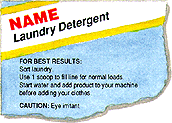 have very low risk, human health effects can still result from unintended exposure. To warn consumers about a specific hazard, household cleaning products carry cautionary labeling whenever necessary. For consumers, this is one of the most important features of the label.
have very low risk, human health effects can still result from unintended exposure. To warn consumers about a specific hazard, household cleaning products carry cautionary labeling whenever necessary. For consumers, this is one of the most important features of the label.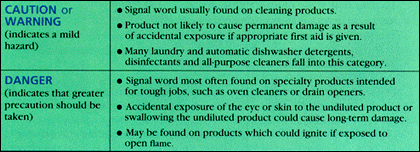
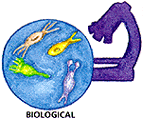 grease, from the wastewater by physical means, i.e., settling and flotation in tanks. The second step, called secondary treatment, removes the dissolved material by biological means, i.e., consumption by microorganisms. It is in the secondary treatment stage where the most important process in reducing the exposure concentration of detergent ingredients occurs. This is called biodegradation. Biodegradation describes how organic (carbon-containing) detergent ingredients, like surfactants, enzymes and fragrances, are broken down into carbon
grease, from the wastewater by physical means, i.e., settling and flotation in tanks. The second step, called secondary treatment, removes the dissolved material by biological means, i.e., consumption by microorganisms. It is in the secondary treatment stage where the most important process in reducing the exposure concentration of detergent ingredients occurs. This is called biodegradation. Biodegradation describes how organic (carbon-containing) detergent ingredients, like surfactants, enzymes and fragrances, are broken down into carbon 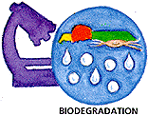 dioxide, water and minerals by the action of microorganisms such as bacteria. At this stage, biodegradation reduces the amount of detergent ingredients discharged into the environment to levels that do not present a risk to fish or other aquatic life. Any small amounts of chemicals which are not biodegraded or removed during sewage treatment are diluted in surface waters, soil and the ocean. They continue to biodegrade or be removed from water by attaching to solids, a process known as adsorption.
dioxide, water and minerals by the action of microorganisms such as bacteria. At this stage, biodegradation reduces the amount of detergent ingredients discharged into the environment to levels that do not present a risk to fish or other aquatic life. Any small amounts of chemicals which are not biodegraded or removed during sewage treatment are diluted in surface waters, soil and the ocean. They continue to biodegrade or be removed from water by attaching to solids, a process known as adsorption.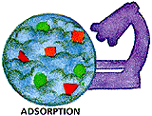 ome inorganic (not carbon-containing) detergent ingredients, such as phosphates, zeolites and some dyes, also attach to solids, and are further treated during processing of the biosolids (sludge) produced in primary and secondary treatment. Biosolids are often used as fertilizers and soil conditioners.
ome inorganic (not carbon-containing) detergent ingredients, such as phosphates, zeolites and some dyes, also attach to solids, and are further treated during processing of the biosolids (sludge) produced in primary and secondary treatment. Biosolids are often used as fertilizers and soil conditioners. Through education and community programs, the soap and detergent industry helps consumers learn how to reduce waste and how best to dispose of it. Consumers are reminded that the environmentally wise way of handling any household cleaning product is to buy only the amount that can be used; to use it all up or give it away; and, if it must be disposed, to dispose of it properly. As a rule of thumb, products designed for use with water should be disposed of by pouring down the drain; solid products such as scouring pads should be put into the trash.
Through education and community programs, the soap and detergent industry helps consumers learn how to reduce waste and how best to dispose of it. Consumers are reminded that the environmentally wise way of handling any household cleaning product is to buy only the amount that can be used; to use it all up or give it away; and, if it must be disposed, to dispose of it properly. As a rule of thumb, products designed for use with water should be disposed of by pouring down the drain; solid products such as scouring pads should be put into the trash.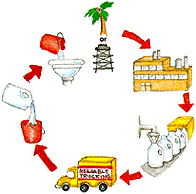 the environmental quality of a product is life cycle assessment (LCA). LCA describes a "cradle-to-grave" look at all the environmental impacts of a product and its package, from acquiring raw materials through manufacture and distribution to consumer use and disposal. One advantage of LCA is that it can determine whether reducing an environmental impact in one area, such as manufacturing, shifts the impact to another, such as disposal. LCA also helps to identify where environmental improvement efforts should be focused.
the environmental quality of a product is life cycle assessment (LCA). LCA describes a "cradle-to-grave" look at all the environmental impacts of a product and its package, from acquiring raw materials through manufacture and distribution to consumer use and disposal. One advantage of LCA is that it can determine whether reducing an environmental impact in one area, such as manufacturing, shifts the impact to another, such as disposal. LCA also helps to identify where environmental improvement efforts should be focused.




